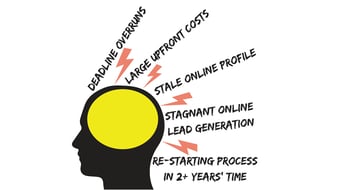Insolvency is understandably a sensitive topic. So marketing yourselves appropriately and positively to businesses and individuals who really need you can be challenging.
Personal insolvencies have risen by 30% in 2017 and corporate insolvencies are 5.3% higher than the previous year. With more businesses requiring insolvency practitioners - and with Brexit around the corner the risks to businesses are on the increase.
So now is the ideal time to think about a long term marketing strategy for your insolvency firm. We have put together four excellent SEO tips to get you started and improve your online visibility.
3. Optimise Your Website for SEO
4. Insolvency Directory Listings
1. Complete an SEO Audit
Insolvency is a relatively small market and your competitors are fighting for every piece of it so SEO will need be the foundation of everything you do online.
SEO has traditionally been viewed as a dark art with a seemingly baffling array of tricks and techniques to improve SEO. Nowadays, it is much more transparent. The major search engines, especially Google tell you what your site needs to do and not do in order to rank highly.
Much of SEO is about content, however, we recommend the first step is always completing a technical SEO audit of your website. You need to ensure you have the fundamentals correct, without these the SEO value of your content will be very limited. An audit will need to include checks on:
- Meta Description - unique description of every page limited to 160 characters
- Title Tag - unique title of every page limited to 50-60 characters
- Alt Tags - unique descriptions of every image on your website
- Make sure there are no broken links or duplicate content on your website
- Make sure you have XML sitemap for Google
There are a number of paid tools available to help with an SEO Audit we recommend having a look at SEMRush or Ahrefs. Alternatively, book a consultation with a member of our team and we can help you with this essential step.
2. Curate Compelling Content
Before you begin churning out content, you need to understand who your target audience is. To do that, you need to create some customer profiles - these are your ideal clients (create customer profiles with our useful free template here so you can get started).
Once you’ve got to grips with who you’re ideally targeting, you can start making fundamental assumptions of your target audience’s pain points and challenges. What would they search for if they needed the service of an insolvency practitioner? This understanding will allow you to create content based around your customer profiles’ problems and solutions. It is these problems and solutions you would want to be ranking for. For example, you can write content such as:
- The Definition of Insolvency
- Why a Business Might Need the Services of an Insolvency Practitioner
- Insolvency 101: What Businesses Should Know
- How to Fill in Your Insolvency Paperwork
- Q+A with an Insolvency Practitioner
- Insolvency FAQs
- ...And so on!
A great content format is a blog. The more blogs you publish, the better it will be for your SEO. The reason for this? Search engines love fresh, quality content. Companies that post 16+ blogs a month receive 3.5 times more traffic than those who only post between one to four blogs a month.
Another factor to consider when writing blog posts is the word length. Google loves good quality, long-form content, so we recommend writing an average of 1,000 words per blog post.
Make sure your blog posts have unique and exciting titles that make your audience want to click on it and read what great content you have to offer. You can use a tool such as CoSchedule headline analyser to determine how well written your page title is and they even give tips on interesting and emotive words to use.
Follow these content best practices and your blogs and website will reap the SEO benefits.
Too much work for your firm? We can help put your mind at ease with our range of marketing services including content and SEO marketing for all your blogging needs. Contact us today to see how we can help.
3. Optimise your Website for SEO
You’ve got the experience, professionalism, and the know-how within your industry and your website should reflect that to your audience.
Nowadays website design is a significant factor used by search engines when deciding where to rank websites. Your website must be optimised for mobile, have excellent page loading times and be able to hold the attention of your website visitors.
No one wants an outdated website that becomes more stale by the day, and isn’t performing to its full potential and losing visitors who drop out after a few seconds - this is what hurts your SEO rankings. This is where the new revolution of web design comes in: Growth-Driven Design (GDD).
In a nutshell, GDD is the process of building and launching a website in under 60 days that really performs. GDD is the gold standard in web design and can save businesses time, money, and the hassle that normally comes with traditional web design methods.
If your website is in need of a refresh to boost your SEO, contact the experts at Digital Media Stream about our growth-driven web design services and how we can bump you up in the search engine rankings with a website that really performs.
4. Insolvency Directory Listings
Listing your insolvency firm’s website on professional directories helps with your local SEO pretty effectively as they create backlinks to your website. The more high quality the directory page, the better it is for the authority ranking of your website. If you’re not already, make sure your firm is listed on some good quality directories such as:
- Insolvency Practitioner Finder | Gov.UK
- Insolvency Directory | Nidirect Government Services
- IP Search | Insolvency Practitioners Association
You can also add your firm to any authoritative general business directories too to help bump your online presence up in the search results. Be sure that wherever you list your business, that all your details - from spelling, spacing, opening times, and so on, are consistent across the web. Google doesn’t like it when things are different.
CONCLUSION
By implementing these four starter SEO tips into your insolvency firm’s marketing strategy, you can begin to ensure that your business is found by the right people who are looking for solutions to their problems at the right time. To re-cap be sure to:
- Implement an SEO strategy that works for your business
- Use SEO optimised content to portray your firm as a thought leader in your industry
- Improve your website and increase leads with GDD
- Ensure your insolvency firm is listed in quality and authoritative directories
Found this useful? There’s more where that came from in marketing for insolvency practitioners. Have a read of our eBook Future-Proof Your Marketing to see how you can stay ahead of the marketing curve. If you nead to feed your SEO needs further, check out Digital Media Stream's SEO services here. Also, don’t forget to leave us a comment below if you have any other SEO tips to add.




